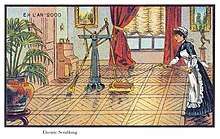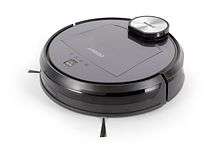Robotic vacuum cleaner
A robotic vacuum cleaner, often called a roomba, is an autonomous robotic vacuum cleaner which has intelligent programming and a limited vacuum floor cleaning system. The original design included manual operation via remote control and a "self-drive" mode which allowed the machine to clean autonomously without human control. Some designs use spinning brushes to reach tight corners, and some include a number of cleaning features along with the vacuuming feature (mopping, UV sterilization, etc.).
An advantage of using a robotic vacuum cleaner is how quiet it is compared to a regular vacuum cleaner.[1] Also, they are seen as more convenient to use because they can vacuum on their own. Robotic vacuums can be kept under beds or desks or in closets, whereas a regular vacuum cleaner requires a larger amount of space. However, a downfall to a robotic vacuum cleaner is that it takes an extended amount of time to vacuum an area due to its size. They are also relatively expensive.[2]
History

In 1996, Electrolux introduced the first “Robotic Vacuum Cleaner”, the Electrolux Trilobite.[3] It worked well but had frequent problems with colliding with objects and stopping short of walls and other objects, as well as leaving small areas not cleaned.[3] As a result, it failed in the market and was discontinued.[3] In 1997, one of Electrolux's first versions of the Trilobite vacuum was featured on the BBC's science program, Tomorrow's World.[4]
In 2001, Dyson built and demonstrated a robot vacuum known as the DC06. However, due to its high price, it was never released to the market.[5]
In 1990, three robotists, Colin Angle, Helen Greiner, and Rodney Brooks, founded iRobot.[6] It was originally dedicated to making robots for military and domestic use. It launched the Roomba in 2002, which was able to change direction when it encountered an obstacle, detect dirty spots on the floor, and identify steep drops to keep it from falling down stairs.[7] The Roomba proved to be the first commercially successful robot vacuum.[8] In 2005, iRobot introduced the Scooba, which scrubbed hard floors.
In 2010, the Neato Robotics XV-11 robotic vacuum introduced laser based mapping, allowing navigation in straight lines rather than the traditional random navigation.[9]
In 2015, Dyson and iRobot both introduced camera based mapping.[10][11]
In 2016, iRobot CEO claimed that 20% of vacuum cleaners sales worldwide were robots.[12]
As of 2018, obstacles such as dog feces, cables and shoes remain very difficult for robots to navigate around.[13][14]
Main features
Health
UV sterilization and HEPA filter.
Cleaning modes
Cleaning types usually include auto mode for general cleaning, scheduled mode, turbo (maximum clean), edge clean for skirting boards and corners, area cleaning mode for cleaning designated areas, spot or spiral mode for spot cleaning a particular zone, and remote mode, allowing the user to steer the robot to a particularly dirty spot.
Wet mopping
Some models can also mop for wet cleaning, autonomously vacuuming and wet-mopping a floor in one pass (sweep and mop combo).
A Robot Mop can tackle multi surfaces and comes with a variety of different cleaning modes giving you options of sweeping, vacuuming and mopping damp or wet floors. The Robot Mop score better on hard floors surface and are ideally suited for hardwood, laminate and tile flooring types
Antidrop
Most robots include anti-drop and anti-bump IR sensors.
Anti-winding
When approaching obstacles, will automatically turn away.
Antitwining
Prevents the robot getting twined by wires.
Mapping

The first robovacs used random navigation. This sometimes caused the unit to miss spots when cleaning or be unable to locate its base station to recharge, and did not provide the user a history of which spaces were cleaned.
More sophisticated models include mapping ability. The unit can use gyro, camera, radar, and laser (laser distance sensor or LDS) guided systems to create a floor plan, which can be permanently stored for more efficiency, and updated with information on areas which have been (or have not been) cleaned. Thus, the cleaning efficiency is greatly improved and the repetition rate is reduced significantly.
Models with a multiple floor plan feature can store several floor plans.
Virtual No-Go lines
Virtual No-Go lines set boundaries, to restrict the unit's movements to desired cleaning areas.
Quick recharge
Most robot vacuums come with a Lithium ion battery of around 2000 mAh that will last long enough to handle approximately 200 m² of floor space (about 100 minutes).
Regular charge time is 5 to 6 hours.
Quick recharge allows the unit to calculate the shortest way to recharge (shortcut path) and charge only as much as needed, so it finishes more quickly (automatic cleaning resumption).
D-shape

A D-shape design can help capture dirt in corners and along walls better than some round units.
Schedule
Scheduled daily cleaning. All-Timetable means a full week of different daily schedules can be programmed.
Connected app
Some models allow control of the unit using an app over a WiFi connection, from your smartphone or connected home automation device, e.g. Amazon Alexa and the Google Assistant.
Software upgrades
Some units are able to receive over the air (OTA) firmware updates.
See also
References
- "10 Benefits of Owning a Robot Vacuum 2020". Best Robot Vacuums 2020. 2019-12-16. Retrieved 2020-01-16.
- "How Robotic Vacuums Work". How Stuff Works. Retrieved 2018-03-05.
- "Invention of Robotic Vacuum Cleaners". Vacuum Cleaner History. Retrieved 2018-03-05.
- "BBC NEWS - Technology - Robot cleaner hits the shops".
- Ulanoff, Lance. "Dyson Wants to Build a Robot Vacuum that Can See".
- "the history of the roomba".
- "Invention of Robotic Vacuum Cleaners". Vacuum Cleaner History. Retrieved 2018-03-05.
- Bennett, Brian. "Why are iRobot's new Roombas so damn expensive?". CNET. Retrieved 2020-05-17.
- "Neato XV-11 robotic vacuum review". Engadget. August 24, 2010. Retrieved 2020-05-17.
- "Deluxe brand Dyson creates its first robot vacuum, the 360 Eye". 2014-09-04. Retrieved 2015-09-26.
- "iRobot Brings Visual Mapping and Navigation to the Roomba 980". IEEE Spectrum: Technology, Engineering, and Science News. 16 Sep 2015. Retrieved 2020-05-17.
- "iRobot says 20 percent of the world's vacuums are now robots". TechCrunch. Retrieved 2020-05-17.
- Solon, Olivia (2016-08-15). "Roomba creator responds to reports of 'poopocalypse': 'We see this a lot'". The Guardian. ISSN 0261-3077. Retrieved 2020-05-17.
- Bryan Heater (2017-12-06). "PerceptIn has raised $11 million to help robotic vacuums and self-driving cars see". TechCrunch. Retrieved 2018-05-25.
External links
| Wikimedia Commons has media related to Robotic vacuum cleaners. |